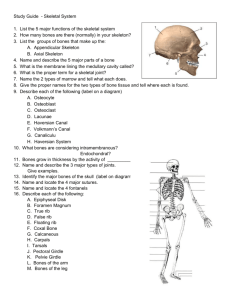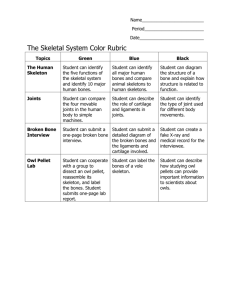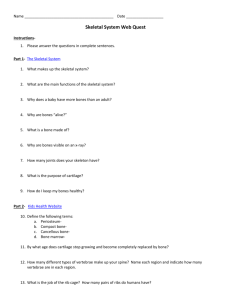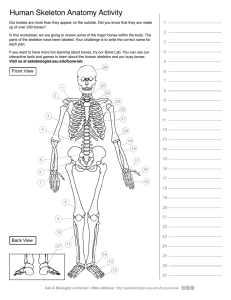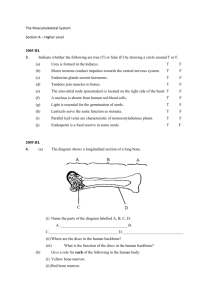CLF248
advertisement
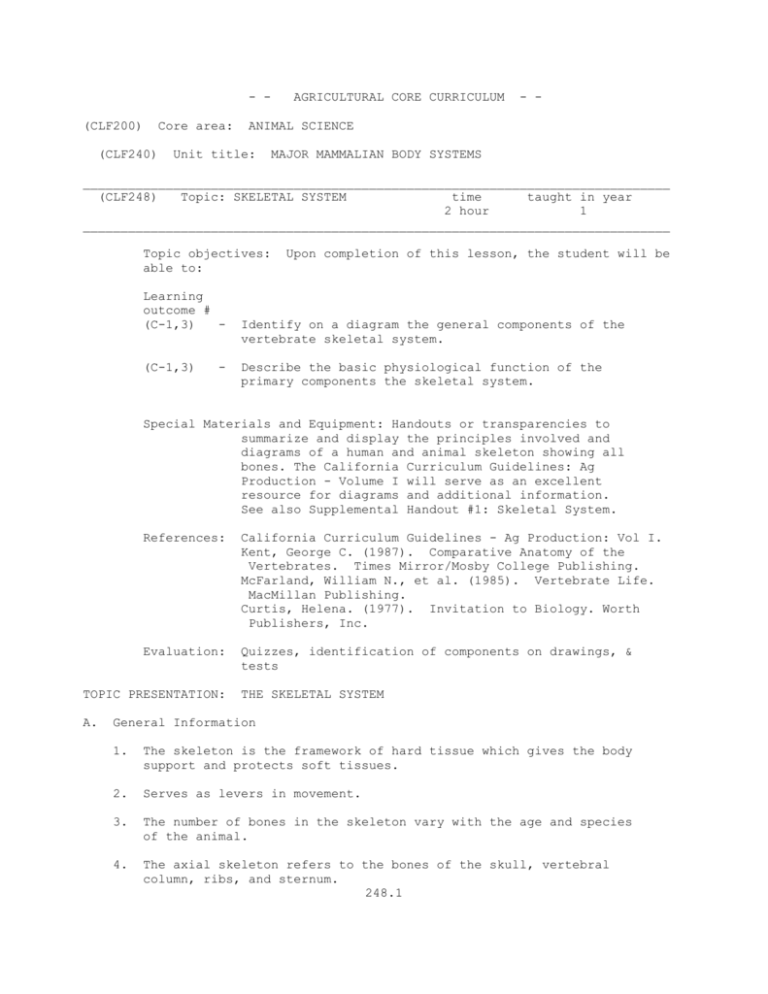
- (CLF200) Core area: (CLF240) AGRICULTURAL CORE CURRICULUM - - ANIMAL SCIENCE Unit title: MAJOR MAMMALIAN BODY SYSTEMS ______________________________________________________________________________ (CLF248) Topic: SKELETAL SYSTEM time taught in year 2 hour 1 ______________________________________________________________________________ Topic objectives: able to: Learning outcome # (C-1,3) (C-1,3) - Upon completion of this lesson, the student will be Identify on a diagram the general components of the vertebrate skeletal system. Describe the basic physiological function of the primary components the skeletal system. Special Materials and Equipment: Handouts or transparencies to summarize and display the principles involved and diagrams of a human and animal skeleton showing all bones. The California Curriculum Guidelines: Ag Production - Volume I will serve as an excellent resource for diagrams and additional information. See also Supplemental Handout #1: Skeletal System. References: California Curriculum Guidelines - Ag Production: Vol I. Kent, George C. (1987). Comparative Anatomy of the Vertebrates. Times Mirror/Mosby College Publishing. McFarland, William N., et al. (1985). Vertebrate Life. MacMillan Publishing. Curtis, Helena. (1977). Invitation to Biology. Worth Publishers, Inc. Evaluation: Quizzes, identification of components on drawings, & tests TOPIC PRESENTATION: A. THE SKELETAL SYSTEM General Information 1. The skeleton is the framework of hard tissue which gives the body support and protects soft tissues. 2. Serves as levers in movement. 3. The number of bones in the skeleton vary with the age and species of the animal. 4. The axial skeleton refers to the bones of the skull, vertebral column, ribs, and sternum. 248.1 B. 5. The appendicular skeleton refers to the limbs. 6. Bones may be described as long (femur), flat (skull), short (vertebrae), and irregular (bones of the pelvis). Bone Structure (See also CLF223 - CELL STRUCTURE) 1. Bone is compact and it contains vessels, nerves, and marrow 2. Bone can repair itself, and can bend. a. The organic material gives it elasticity and the inorganic material gives it rigidity. (The older the animal becomes, the harder and more brittle the bones become.) __________________________________________________________ ACTIVITIY: 1. Obtain diagrams of a pair of skeletons, one of of man, the other of an animal for use in this section. Real examples of skeletons could be used to reinforce the leaning 2. On each diagram, have the students identify the "general components" described below. each of 3. If you do not have a more source for a more detailed diagram, the California Curriculum Guidelines: Ag Production - Volume I will serve as an excellent resource. __________________________________________________________ C. General Components of the Skeleton 1. The skull includes the following: a. nasal cavity, b. mandible, c. temporal bone, d. sinuses - hollow walled spaces, and e. turbinates - cartilaginous bone (not hard) covered by highly vascular (many blood vessels) mucosa which serves to clean and warm the air as the animal breathes in. 2. The vertebral column includes the cervical, thoracic, lumbar, sacral, and coccygeal sections. (If you wish to conduct a more detailed discussion on this section, provide the students with Supplement Handout #1: Skeletal System.) a. It protects the spinal cord which runs up the hollow middle of the vertebra. 248.2 1) b. D. Some vertebra are moveable, others are not. The vertebral column serves as an attachment for the appendicular skeleton - examples include: 1) the ribs which attach to the column; the thoracic limbs (arms or front legs) - including the scapula or shoulder blade, arm, radius and ulna or forearm, manus, the carpus, metacarpus, and digits. 2) the pelvic limbs (legs or hind legs) - including: pelvic girdle, ilium, ischium, pubis, femur, leg - tibia, fibula, patella, etc Articulation of the joints 1. Immovable joints are those with no intervening tissue between the bones (skull). 2. Freely moveable joints are those that can move in several directions like those of the shoulders and hips. 3. The cavity of the joint (hollow pocket) may contain "synovial" fluid, which is secreted (point out the correct use of the term) by the "synovial membrane". The fluid helps lubricate the joint. 4. Ligaments are the strong white fibrous tissues that connect bone to bone. 5. The tendons are dense cord-like tissues that connect the muscles to the bones. ****************************************************************************** INSTRUCTORS PLEASE NOTE: The following goes beyond the scope of the curriculum for the Basic Core, and is included here for reference and /or as a source for local enrichment. The resource used was the California Curriculum Guideline: Ag Production - Vol. I. ****************************************************************************** As an example for application, students may study the skeletal anatomy of the horse - - Skeletal Anatomy of the Horse - __________________________________________________________ ACTIVITIY: Obtain a diagram of the skeleton of the horse and provide a copy for each student to use as the following discussion takes place __________________________________________________________ 248.3 A. The Skeletal System 1. is the framework of hard structures which supports and protects the soft tissue (a total of 205 bones). Bone is composed of 1/3 organic and 2/3 inorganic material. 2. The axial skeleton includes all of those items listed below. a. The skull. b. The spinal column which is composed of vertebrae. The major divisions are the: 1) 2) 3) 4) 5) cervical or neck area a) involved with head and neck movement, and b) is the most flexible part of the axial skeleton. thoracic area a) which forms the upper wall of the chest cavity with the 18 ribs attached; b) peaks at the summit of the withers; and c) has limited movement and flexibility. lumbar group (lower back) a) which usually includes 6 vertebra (Arabians may have 5); b) provides the framework for the loin area; and c) greater flexibility than in the thoracic group but less than the cervical group. sacral group (rump) a) which includes five vertebrae fused into one bone (sacrum); b) is the highest point of the croup; and c) is connected by a firm joint with the hip (pelvis) bones on each side of the sacrum. Coccygeal(tail) a) b) 3. (shoulders) - 15 - 21 coccygeal vertebrae; and essentially no spinal canal through the middle of the vertebra. Appendicular skeleton (the four legs) is 248.4 a. used for locomotion and can also be used for eating and defense; and b. connects with the axial skeleton by muscles and in the case of the hind leg, by bony joints and muscles. c. The foreleg includes: 1) the scapula (shoulder blade) which is flat and triangular in shape; 2) the humerus that extends down and back from the scapula; 3) the radius and ulna which are - 4) 5) a) fused together, and b) connect with the humerus and form the elbow joint; the carpal bones include a) the knee bones, and b) serve to absorb and dissipate concussive action (the pounding of the hooves as the animal runs); the metacarpal bones (three) - which extend from the knee to fetlock; d. 6) the phalanges (three) - which corresponds to the hand of man, 7) the sesamoids - form part of th fetlock joint; and 8) the distal or navicular bone - located at the rear of the coffin bone. The hindleg includes: 1) 2) 3) the femur a) which is the largest bone of the upper leg, and b) corresponds to the thigh bone of man; the patella a) is the small bone in front of the stifle joint, and b) corresponds with the kneecap of man; the tibia and fibula a) corresponds with the shin bone of man, and 248.5 b) starts at the stifle joint, extends downward and backward to the hock joint; 4) the tarsus (hock); 5) the metatarsus or cannon bone of the hindleg; and 6) the phalanges and sesamoids of the hindlegs that correspond to those of the foreleg. __________________________________________________________ ACTIVITIY: To provide further practice, provide the with the appropriate diagrams so that they may, using Supplement Worksheet #1" Skeleton of the the Horse, identify and label many of the bones found in a typical vertebrate body. __________________________________________________________ 248.6 Supplemental Handout #1 - - SKELETAL SYSTEM: REFERENCE ON THE VERTEBRAE AND VERTEBRAL COLUMN - - Cervical: The flexible group of cervical vertebrae supports the skull and and neck. Holding the head erect develops and maintains its curvature. The 1st and 2nd cervical vertebrae are unique as is the 7th with its prominent spine. The foramina in the transverse processes of C1-C6 transmit the vertebral arteries to the base of the brain. The series of vertebral foramina form a canal for the spinal cord. Thoracic: This rather rigid group of thoracic vertebrae and the 24 ribs with which they articulate support the thorax. Its prominent curvature is developed in fetal life. Thoracic vertebrae are characterized by long slender spines, heart-shaped bodies, and facets for rib articulation. Lumbar: These stubby, quadrilateral lumbar vertebrae, the most massive of the column, carry a large share of the body weight, balancing the torso on the sacrum. The lumbar curvature results from walking and standing erect. This vertebral group is quite mobile; when lifting from the floor by flexing this group, great pressure is often put on their discs, which may induce their rupture. This may injure the spinal nerves which pass from the spinal cord through the intervertebral foramina. Sacrum: Five sacral vertebrae fuse to form this single bone. It transmits the body weight to the hip joints via its articulation with the pelvic guide. Coccyx: Consisting of 2 to 4 fused coccygeal vertebrae, the functionally insignificant coccyx represents the vestigial tail of our forebears. 248.7 Supplemental Worksheet #1 - - Skeletal Components of the Horse - - Label the following on the diagrams of the horse provided to you. using the names, not the numbers. GENERAL SKELETON OF A HORSE 1. 2. 3. 4. 5. 6. 7. 8. 9. 10. 11. 12. 13. 14. 15. 16. 17. Thoracic vertebrae Lumbar vertebrae Sacrum Shaft of ilium Coccygeal vertebrae Hip joint Femur Patella Tibia Fibula Tarsus Metatarsus Stifle Pubis False ribs True ribs Proximal sesamoid bones 18. 19. 20. 21. 22. 23. 24. 25. 26. 27. 28. 29. 30. 31. 32. 33. Ulna Coffin joint Pastern joint Fetlock joint Metacarpus Carpus Radius Elbow joint Sternum Humerus Shoulder joint Scapula Mandible Facial bones Cranial bones Cervical vertebrae HORSE LEG BONES 1. 2. 3. 4. 5. 6. 7. 8. 9. 10. 11. 12. 13. 14. 15. 16. Cartilage of scapula Scapula Scapular spine Humerus Olecranon Ulna Radius Carpus Metacarpus Fetlock joint Proximal Sesamoid bones Pastern joint Proximal phalanx Coffin joint Middle phalanx Distal phalanx 17. 18. 19. 20. 21. 22. 23. 24. 25. 26. 27. 28. 29. 30. Ilium Pubis Ischium Femur Patella Fibula Tibia Fibial tarsal Tibial tarsal Fourth tarsal Tarsals Metatarsal IV Metatarsal III Phalanges of the foot FOOT OF A HORSE 1. 2. 3. 4. 5. Skin Tendon of common extensor Metacarpal bone Capsule of fetlock joint Fetlock joint 13. Sole 14. Corium of sole 15. Third phalanx 16. Deep flexor tendon 17. Distal sesamoid bone 248.8 Label them 6. 7. 8. 9. 10. 11. 12. Middle sesamoid ligament First phalanx Pastern joint Second phalanx Coffin joint Periople Coronary corium 18. 19. 20. 21. 22. 23. 24. Digital cushion Frog Superficial sesamoid ligament Intersesamoid ligament Superficial flexor tendon Fibrous tissue Ergot 248.9
